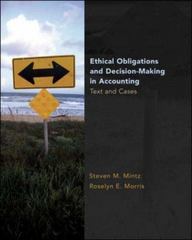Question
Bonuses for the directors of MP were set at the start of the budget year based on return on assets (ROA), as shown in Table
Bonuses for the directors of MP were set at the start of the budget year based on return on assets (ROA), as shown in Table 1. ROA is calculated as the profit for the year divided by the average of the opening and closing asset base (total assets less current liabilities), as recorded in the management accounts.
Maple Products owns its premises in Leeds outright and the land and buildings were revalued three years ago; the revalued amount is recorded in the management accounts (net of depreciation). The plant and machinery in Leeds is old but serviceable and currently has a very low net book value. Due to frequent shipping delays, MP holds high levels of raw materials inventory; trade receivable levels are also high because MP sells to major wholesalers who negotiate long periods of credit. All these factors contribute to the asset base used in the calculation of ROA.
ROA is the standard measure used by Kan Enterprises for all its divisions. The median ROA in the air conditioning sector is 14%. The top quartile reports a ROA of 17% or more.
Table 1. Return on Assets
Asset
GBP
Budgeted profits for the year
10,575,000
Asset base at the start of the year
58,925,000
Budgeted asset base at the end of the year
69,500,000
Average asset base
64,212,500
ROA (using average of opening and closing assets)
16.5%
Note: ROA: Return on assets
- Bonus Ratchet
The agreement Kan Enterprises established with the team at MP was that when the ROA exceeds 15%, the Maple Products directors receive a bonus equal to 10% of salary. There is also an incentive ratchet, with a bonus of 15% of salary if ROA exceeds 18.5%, or a bonus of 20% of salary if ROA exceeds 22%.
The base bonus (10% of salary) results in directors' total remuneration being around the median for the sector. A bonus of 15% of salary puts the directors just below the top quartile for the sector, while a bonus of 20% of salary puts the directors just below the top decile for the sector.
Detail of Budgeted Profit for the Year
Gloria Kan inspected the detailed original budget for Maple Products (Table 2), prepared the previous January.
Table 2. Original Budgeted Profit for Year Ended 31 December
- Units sold 3,900,000
- Budget item (GBP)
- Sales revenues - Europe 25.00 per unit 97,500,000 total
- Variable costs
- Direct materials 4.68 per unit 18,252,000 total
- Direct labour 5.90 per unit 23,010,000 total
- Variable production overhead 3.90 per unit 15,210,000 total
- Variable selling expenses 2.00 per unit 7,800,000 total
- Total variable costs 16.48 per unit 64,272,000
- Income
- Contribution from pumps 8.52 per unit 33,228,000 total
- Net income from repairs and maintenance 1,050,000 total
- Profits before fixed costs 34,278,000 total
- Fixed costs
- Fixed production overhead 5,551,000 total
- Fixed selling expenses 8,567,000 total
- Fixed administration costs 9,585,000 total
- Total fixed costs 23,703,000
- Budgeted profit for the year 10,575,000
The managing director of MP has overall responsibility for achieving the profit for the year; this director is also responsible for MP investment decisions.
EMEA Regional Report
The team in charge of businesses in the EMEA (Europe, the Middle East, and Africa) region also prepared business notes, which include details on Maple Products. Some events had occurred after the original budget was drawn up and were not reflected in the figures in Table 2.
The EMEA report noted that a new sales office had been set up in April for Maple Products using unoccupied space at Kan Enterprises' headquarters in Hong Kong, to take advantage of Kan Enterprises' contacts in the Asia-Pacific region. The estimate for sales in the Asia-Pacific region at the time of this development was in the order of 300,000 units from April to December (this would have resulted in 4,200,000 total units sold for the year). However, the sales office had been enormously successful, resulting in 600,000 units sold in the Asia-Pacific region, and therefore worldwide sales of 4,500,000 units for the year.
Questions
- 1.
Using the budgeted data in Table 2, calculate (a) the total budgeted profits for sales of 4,200,000 units and 4,500,000 units and (b) the sales volume variance (differences in profits from the original budgeted profits) for sales of 4,200,000 units and 4,500,000 units. Note: Net income from repairs and maintenance is not expected to change with the increase in output because most new units do not require repairs or maintenance in the first year.
- 2.
Calculate the budgeted ROA for sales outputs of 4,200,000 and 4,500,000 units. Assume that any additional profits over the original budget will be invested in the business and therefore increase the budgeted closing asset base
Step by Step Solution
There are 3 Steps involved in it
Step: 1

Get Instant Access to Expert-Tailored Solutions
See step-by-step solutions with expert insights and AI powered tools for academic success
Step: 2

Step: 3

Ace Your Homework with AI
Get the answers you need in no time with our AI-driven, step-by-step assistance
Get Started


